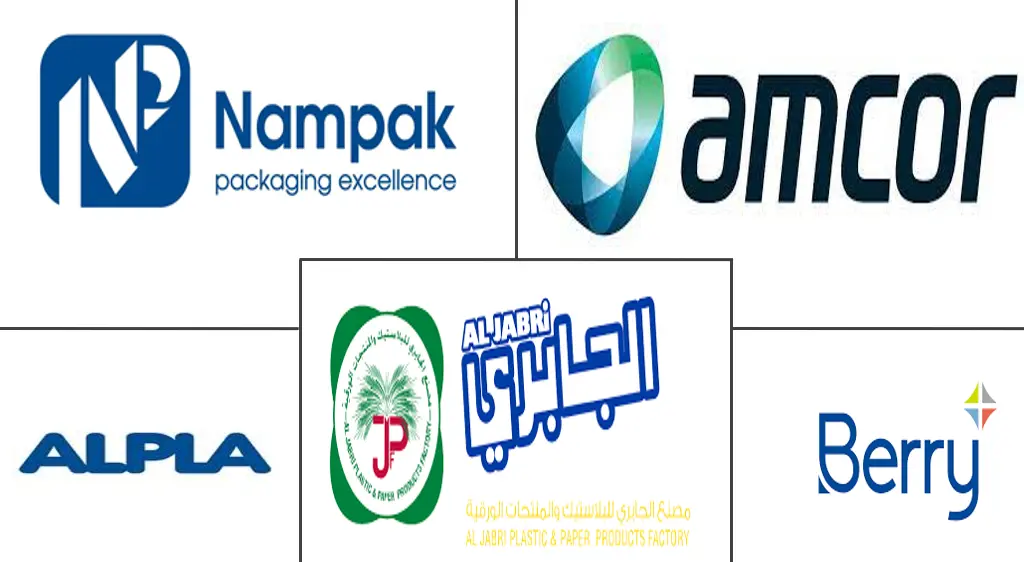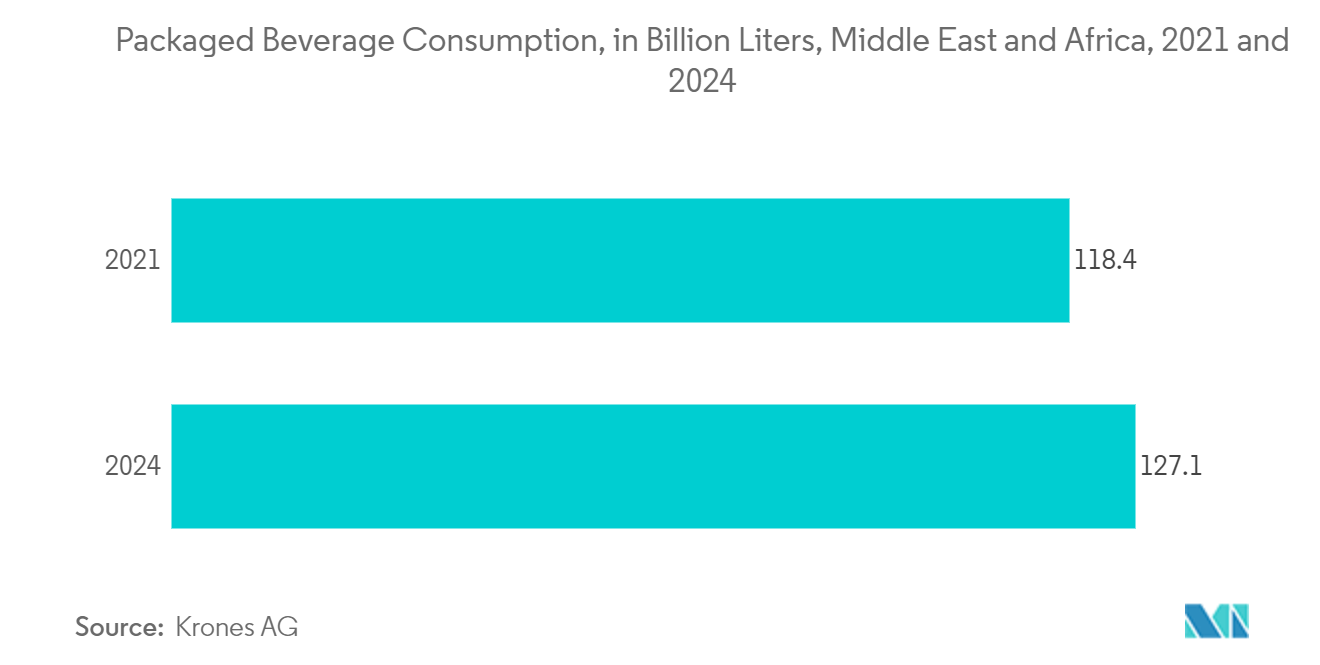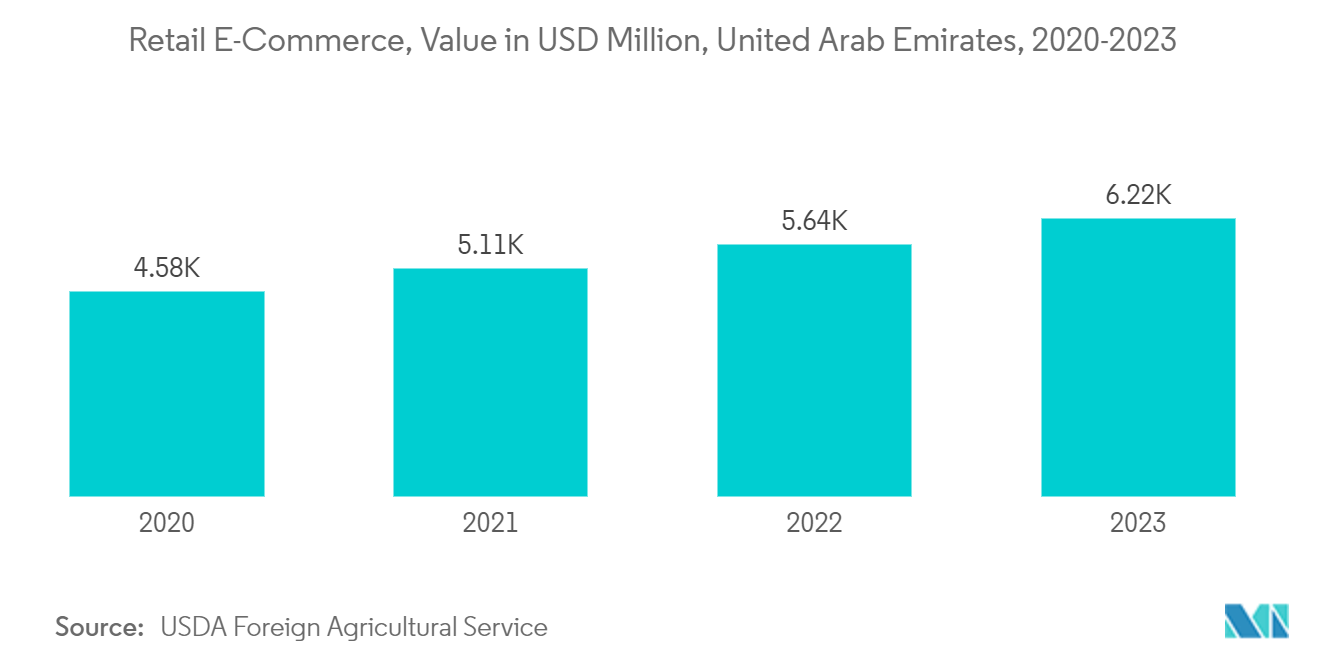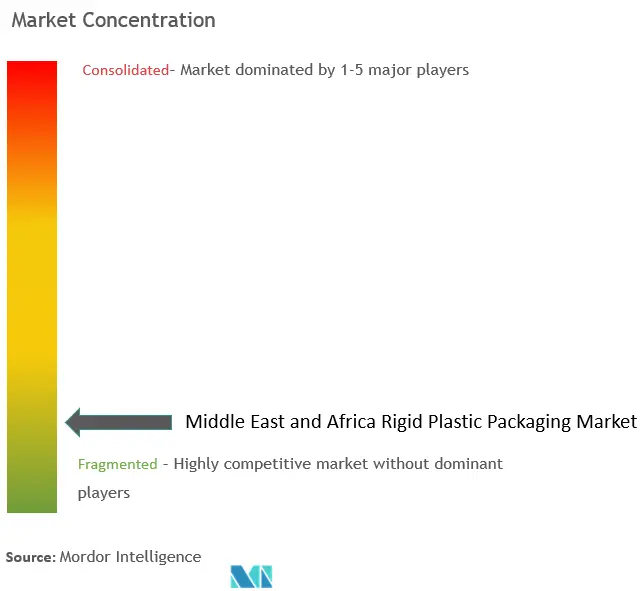MEA Rigid Plastic Packaging Market Size

| Study Period | 2019 - 2029 |
| Base Year For Estimation | 2023 |
| Market Volume (2024) | 4.48 Million tonnes |
| Market Volume (2029) | 5.39 Million tonnes |
| CAGR (2024 - 2029) | 3.76 % |
| Market Concentration | Low |
Major Players
*Disclaimer: Major Players sorted in no particular order |
MEA Rigid Plastic Packaging Market Analysis
The MEA Rigid Plastic Packaging Market size in terms of shipment volume is expected to grow from 4.48 Million tonnes in 2024 to 5.39 Million tonnes by 2029, at a CAGR of 3.76% during the forecast period (2024-2029).
- Rigid plastic packaging is revolutionizing the rigid plastic packaging market in Middle East and Africa, serving as a cornerstone for numerous sectors that rely on packaging for their products. The recyclable rigid plastic packaging products are made of plastic jars with open tops and independent lids, closures, or covers. Large rigid containers are widely used in supermarkets and shops to transport various products, including foods, products, and pharmaceuticals. Therefore, rigid plastics' durability and ability to be recycled are the main factors driving the market in the region.
- Governments across the region are supporting the adoption of recyclable plastic in the mainstream of packaging solutions and creating an environment to develop recyclable packaging manufacturing facilities in the region, which is expected to drive the market during the forecast period. For instance, in January 2023, the UAE Ministry of Industry and Advanced Technology (MoIAT) published a decree regulating the sale of recycled plastic water bottles according to the highest standards of food safety and public health in order to attract new investments by expanding the plastic recycling industry.
- In Middle East and Africa, the demand for rPET is on the rise. In the United Arab Emirates, consumers are increasingly letting sustainability guide their purchasing choices. In January 2023, Abu Dhabi inaugurated its first-ever food-grade plastic recycling facility. This facility addressed general plastic waste and zeroed in on recycling PET, a prevalent material in food packaging, especially in water bottles.
- The region's demand for rigid plastic packaging is climbing, driven by a robust consumer base and a spectrum of industrial activities that extend beyond the predominant oil and gas sector. According to insights from the Saudi Industrial Fund (SIDF), there has been a significant shift in Saudi Arabia's industrial scene. According to SIDF, the country is home to 791 food manufacturing facilities, 173 beverage manufacturers, 94 textile producers, 102 apparel makers, and 45 pharmaceutical establishments. Together, they account for 16% of Saudi Arabia's industrial manufacturing landscape and play a crucial role in driving the demand for rigid plastic packaging.
- Plastics represent a severe environmental risk if they are not managed appropriately at the start of the value chain and throughout their prolonged existence, especially in the ocean. Due to increased plastic production and use in the Arabian Gulf and shipping and waste disposal practices, the amount of plastic waste on the ocean's surface and beaches has increased. Plastic packaging companies must adhere to suitable recycling regulations to introduce their products in the region, restricting market growth.
MEA Rigid Plastic Packaging Market Trends
Polyethylene Terephthalate (PET) Occupies the Largest Market Share
- PET packaging, known for its lightweight nature, durability, and ease of handling, is extensively used in the food and beverage industry. Due to advancements in packaging technology, PET has made significant inroads into the health and cosmetics industries as well.
- Polyethylene terephthalate (PET) is the leading choice for packaging a variety of beverages, including carbonated soft drinks, fruit juices, and bottled water. PET has a lower carbon footprint than its counterparts and is also lightweight, durable, and safe. Notably, PET is recognized as the world's most recyclable plastic, which can be converted into rPET (recycled PET).
- The United Arab Emirates, Qatar, and Saudi Arabia are home to some of the world's top tourist attractions. As a result, these regions are bustling with various food and beverage establishments, offering exceptional culinary experiences. Many travelers prefer on-the-go food and drinks, leading to a surge in demand for packaged beverages like energy drinks and bottled water.
- Responding to the government's push for eco-friendly packaging, numerous companies are debuting sustainable PET products, potentially boosting the demand for PET items. In March 2023, Al Ain Water garnered attention by rolling out the United Arab Emirates' first-ever rPET bottle, underscoring its dedication to sustainable packaging. Notably, Al Ain Water previously led the Middle East's sustainability efforts with the launch of the region's first 100% plant-based water bottle.
- Krones AG, a leading global manufacturer of packaging and bottling machines, reported that Middle East and Africa is expected to witness a rise in packaged beverage consumption from 118.40 billion liters in 2021 to 127.10 billion liters in 2024. This upward trend is expected to continue further, bolstering the demand for PET bottle manufacturing and closures.

The United Arab Emirates (UAE) is Expected to Record Significant Growth
- The country's pharmaceutical industry has witnessed significant growth in the past few years owing to the growing government initiatives and the rise in the production capacity of medicines. This growth is creating considerable growth opportunities for market vendors as different plastic types, such as high-density polyethylene (HDPE), low-density polyethylene (LDPE), and polyethylene terephthalate (PET), are widely used in pharmaceutical packaging. For instance, HDPE is the most common rigid plastic for solid pharmaceutical products, creating moisture-resistant and structurally rigid containers.
- Companies in the United Arab Emirates have increased their production capacity by enhancing manufacturing capacities, driving the demand for medicine packaging, and creating opportunities for rigid plastic packaging market vendors. For instance, Bioventure Healthcare, a United Arab Emirates-based pharmaceutical manufacturing company, planned to double the production capacity of its factory by launching new lines of tablets, capsules, and sachets, which would generate demand for plastic packaging, including blister packaging, in the country.
- As part of Dubai's 2030 Industrial Strategy, the city is seeking to become a global leader in the manufacturing and industrial sectors while at the same time bringing significant investments into all critical sectors. The Dubai Industrial Strategy 2030 envisages further growth of USD 5 billion in the industrial sector by 2030. As the region's cosmetics and beauty industries develop, the need for rigid plastic packaging is growing.
- According to the Department of Economic Development (Dubai), in 2023, e-commerce sales in the United Arab Emirates (UAE) were around USD 577 million. E-commerce businesses often require customized packaging to enhance their brand identity and improve customer experience. Rigid plastic packaging can be efficiently designed, molded, and printed upon, allowing companies to create unique, eye-catching packaging designs.
- Dubai has many international cafeterias and food service restaurants. There is a rise in demand for coffee across the market from a new generation of coffee drinkers who expect better beans, methods, and additives. In January 2023, Peet's Coffee, the business that initiated the craft coffee revolution in the United States, unveiled the opening of its first Middle Eastern branch, an upscale coffee bar in Dubai, to address the growing demand in collaboration with Americana Restaurants. The continuous development of coffee and snack outlets indicates the rising demand for bottles, serving trays, closures for coffee cups, and other rigid plastic products.

MEA Rigid Plastic Packaging Industry Overview
The rigid plastic packaging market in the Middle East and Africa is fragmented. Manufacturers seek lightweight, high-performing plastic grades to reduce costs and improve packaging performance. Some of the most well-known rigid plastic packaging manufacturers include Amcor PLC, ALPLA, Nampak Ltd, Al Jabri Plastics, and Polyoak Packaging Group.
- May 2024: ALPLA, a global packaging specialist, and Refriango, a beverage producer, jointly launched their second in-house plant at Refriango's Viana site in Angola. This strategic initiative is designed to boost operational efficiency, increase production capacity, and lower the carbon footprint of both entities. The newly inaugurated facility, named ALPLA Sopro, is specifically focused on the production of secure, cost-effective, and eco-friendly plastic packaging.
- July 2023: Packaging specialist ALPLA launched a new brand, ALPLArecycling. The plastic packaging company had 13 plants, including four joint ventures with regional partners. It aims to process at least 25% post-consumer (PCR) material by 2025. After investing millions into new sites in South Africa, Romania, and Thailand, as well as a site extension in Poland, ALPLA consolidated all its activities under ALPLArecycling.
MEA Rigid Plastic Packaging Market Leaders
-
Berry Global Inc.
-
Amcor Group GmbH
-
ALPLA Group
-
Nampak Ltd.
-
Al Jabri Plastics
*Disclaimer: Major Players sorted in no particular order

MEA Rigid Plastic Packaging Market News
- March 2023: Al Ain Water, a water provider in the United Arab Emirates, launched its 100% rPET bottle. This was the first time a local water brand produced rPET bottles in the United Arab Emirates.
- March 2023: SOREMA, a leading name in polymer washing and recycling, partnered with Austrian firm Starlinger to set up a cutting-edge recycling facility for post-consumer PET bottles at OK Plast's site in the Democratic Republic of Congo. The plant, tailored for OK Plast's needs, focuses on producing rPET flakes specifically designed for food packaging preforms. SOREMA's African production unit is pivotal in advancing the continent's circular economy. It achieves this by upcycling rPET, which is increasingly being incorporated into preforms, bottles, and food container manufacturing.
MEA Rigid Plastic Packaging Market Report - Table of Contents
1. INTRODUCTION
1.1 Study Assumptions and Market Definition
1.2 Scope of the Study
2. RESEARCH METHODOLOGY
3. EXECUTIVE SUMMARY
4. MARKET INSIGHTS
4.1 Market Overview
4.2 Industry Value Chain Analysis
4.3 Industry Attractiveness - Porter's Five Forces Analysis
4.3.1 Bargaining Power of Suppliers
4.3.2 Bargaining Power of Buyers/Consumers
4.3.3 Threat of New Entrants
4.3.4 Threat of Substitutes
4.3.5 Intensity of Competitive Rivalry
4.4 Trade Scenario
4.4.1 Trade Analysis (Top 5 Import-Export Countries)
4.5 Industry Regulation, Policy and Standards
4.6 Technology Landscape
4.7 Pricing Trend Analysis
4.7.1 Plastic Resins (Current Pricing and Historic Trends)
5. MARKET DYNAMICS
5.1 Market Drivers
5.1.1 Demand for Recyclable Rigid Plastic Packaging is Expected to Grow Due to the New Regulation
5.1.2 Increasing Demand for Rigid Plastic Packaging to Extend Shelf Life of Products
5.2 Market Restraints
5.2.1 Environmental Concerns Over Safe Disposal and Price Volatility of the Raw Materials
6. MARKET SEGMENTATION
6.1 By Resin Type
6.1.1 Polyethylene (PE)
6.1.1.1 Low-Density Polyethylene (LDPE) & Linear Low-Density Polyethylene (LLDPE)
6.1.1.2 High Density Polyethylene (HDPE)
6.1.2 Polyethylene terephthalate (PET)
6.1.3 Polypropylene (PP)
6.1.4 Polystyrene (PS) and Expanded polystyrene (EPS)
6.1.5 Polyvinyl chloride (PVC)
6.1.6 Other Resin Types
6.2 By Product Type
6.2.1 Bottles and Jars
6.2.2 Trays and Containers
6.2.3 Caps and Closures
6.2.4 Intermediate Bulk Containers (IBCs)
6.2.5 Drums
6.2.6 Pallets
6.2.7 Other Product Types
6.3 By End-use Industries
6.3.1 Food
6.3.1.1 Candy & Confectionery
6.3.1.2 Frozen Foods
6.3.1.3 Fresh Produce
6.3.1.4 Dairy Products
6.3.1.5 Dry Foods
6.3.1.6 Meat, Poultry, And Seafood
6.3.1.7 Pet Food
6.3.1.8 Other Food Products
6.3.2 Foodservice
6.3.2.1 Quick Service Restaurants (QSRs)
6.3.2.2 Full-Service Restaurants (FSRs)
6.3.2.3 Coffee and Snack Outlets
6.3.2.4 Retail Establishments
6.3.2.5 Institutional
6.3.2.6 Hospitality
6.3.2.7 Others Food Service Sectors
6.3.3 Beverage
6.3.4 Healthcare
6.3.5 Cosmetics and Personal Care
6.3.6 Industrial
6.3.7 Building and Construction
6.3.8 Automotive
6.3.9 Other End User Industries
6.4 By Country***
6.4.1 United Arab Emirates
6.4.2 Saudi Arabia
6.4.3 Egypt
6.4.4 South Africa
6.4.5 Nigeria
6.4.6 Morocco
7. COMPETITIVE LANDSCAPE
7.1 Company Profiles*
7.1.1 Amcor Group GmbH
7.1.2 Berry Global Inc.
7.1.3 ALPLA Group
7.1.4 Nampak Ltd
7.1.5 Al Jabri Plastics
7.1.6 Takween Advanced Industries (Plastico SPS)
7.1.7 Precision Plastic Products Co. (LLC)
7.1.8 Al Amana Plastic Bottles & Containers Manufacturing LLC
7.1.9 Zamil Plastic Industries
7.1.10 AL-Ghandoura Co. Manuf. Plastic
7.1.11 Silafrica Plastics & Packaging International Ltd
7.1.12 Polyoak Packaging Group
7.2 Heat Map Analysis
7.3 Competitor Analysis - Emerging vs. Established Players
8. RECYCLING & SUSTAINABILITY LANDSCAPE
9. FUTURE OUTLOOK
MEA Rigid Plastic Packaging Industry Segmentation
The study tracks the demand for rigid plastic packaging products catering to the food, foodservice, beverage, healthcare, personal care, cosmetic industries, industrial, building and construction, automotive, and other end-user industries. Rigid plastics can be of different grades and different material combinations based on the type of product being packed, like polyethylene, polypropylene, polyvinyl chloride, polyethylene terephthalate, and bio-plastics.
The Middle East and Africa rigid plastic packaging market is segmented by resin type (polyethylene (PE) (low-density polyethylene (LDPE) & linear low-density polyethylene (LLDPE) and high-density polyethylene (HDPE)), polyethylene terephthalate (PET), polypropylene (PP), polystyrene (PS) and expanded polystyrene (EPS), polyvinyl chloride (PVC), and other resin types), product type (bottles and jars, trays and containers, caps and closures, intermediate bulk containers (IBCs), drums, pallets, and other product types), end-user industry (food (candy & confectionery, frozen foods, fresh produce, dairy products, dry foods, meat, poultry, and seafood, pet food, and other food products), foodservice (quick service restaurants (QSRs), full service restaurants (FSRs), coffee and snack outlets, retail establishments, institutional, hospitality, and others foodservice sectors), beverages, healthcare, cosmetics and personal care, industrial, building and construction, automotive, and other end-user industries), and country (the United Arab Emirates, Saudi Arabia, Egypt, South Africa, Nigeria, Morocco, and Rest of Middle East and Africa). The market sizes and forecasts are provided in terms of volume (tonnes) for all the above segments.
| By Resin Type | ||||
| ||||
| Polyethylene terephthalate (PET) | ||||
| Polypropylene (PP) | ||||
| Polystyrene (PS) and Expanded polystyrene (EPS) | ||||
| Polyvinyl chloride (PVC) | ||||
| Other Resin Types |
| By Product Type | |
| Bottles and Jars | |
| Trays and Containers | |
| Caps and Closures | |
| Intermediate Bulk Containers (IBCs) | |
| Drums | |
| Pallets | |
| Other Product Types |
| By End-use Industries | ||||||||||
| ||||||||||
| ||||||||||
| Beverage | ||||||||||
| Healthcare | ||||||||||
| Cosmetics and Personal Care | ||||||||||
| Industrial | ||||||||||
| Building and Construction | ||||||||||
| Automotive | ||||||||||
| Other End User Industries |
| By Country*** | |
| United Arab Emirates | |
| Saudi Arabia | |
| Egypt | |
| South Africa | |
| Nigeria | |
| Morocco |
MEA Rigid Plastic Packaging Market Research FAQs
How big is the MEA Rigid Plastic Packaging Market?
The MEA Rigid Plastic Packaging Market size is expected to reach 4.48 million tonnes in 2024 and grow at a CAGR of 3.76% to reach 5.39 million tonnes by 2029.
What is the current MEA Rigid Plastic Packaging Market size?
In 2024, the MEA Rigid Plastic Packaging Market size is expected to reach 4.48 million tonnes.
Who are the key players in MEA Rigid Plastic Packaging Market?
Berry Global Inc., Amcor Group GmbH, ALPLA Group, Nampak Ltd. and Al Jabri Plastics are the major companies operating in the MEA Rigid Plastic Packaging Market.
What years does this MEA Rigid Plastic Packaging Market cover, and what was the market size in 2023?
In 2023, the MEA Rigid Plastic Packaging Market size was estimated at 4.31 million tonnes. The report covers the MEA Rigid Plastic Packaging Market historical market size for years: 2019, 2020, 2021, 2022 and 2023. The report also forecasts the MEA Rigid Plastic Packaging Market size for years: 2024, 2025, 2026, 2027, 2028 and 2029.
MEA Rigid Plastic Packaging Industry Report
Statistics for the 2024 MEA Rigid Plastic Packaging market share, size and revenue growth rate, created by ����vlog��ý™ Industry Reports. MEA Rigid Plastic Packaging analysis includes a market forecast outlook to for 2024 to 2029 and historical overview. Get a sample of this industry analysis as a free report PDF download.



